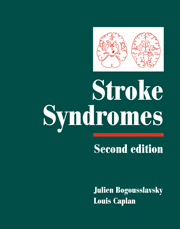Book contents
- Frontmatter
- Contents
- List of contributors
- Preface
- PART I CLINICAL MANIFESTATIONS
- PART II VASCULAR TOPOGRAPHIC SYNDROMES
- 29 Arterial territories of human brain
- 30 Superficial middle cerebral artery syndromes
- 31 Lenticulostriate arteries
- 32 Anterior cerebral artery
- 33 Anterior choroidal artery territory infarcts
- 34 Thalamic infarcts and hemorrhages
- 35 Caudate infarcts and hemorrhages
- 36 Posterior cerebral artery
- 37 Large and panhemispheric infarcts
- 38 Multiple, multilevel and bihemispheric infarcts
- 39 Midbrain infarcts
- 40 Pontine infarcts and hemorrhages
- 41 Medullary infarcts and hemorrhages
- 42 Cerebellar stroke syndromes
- 43 Extended infarcts in the posterior circulation (brainstem/cerebellum)
- 44 Border zone infarcts
- 45 Classical lacunar syndromes
- 46 Putaminal hemorrhages
- 47 Lobar hemorrhages
- 48 Intraventricular hemorrhages
- 49 Subarachnoid hemorrhage syndromes
- 50 Brain venous thrombosis syndromes
- 51 Carotid occlusion syndromes
- 52 Cervical artery dissection syndromes
- 53 Syndromes related to large artery thromboembolism within the vertebrobasilar system
- 54 Spinal stroke syndromes
- Index
- Plate section
47 - Lobar hemorrhages
from PART II - VASCULAR TOPOGRAPHIC SYNDROMES
Published online by Cambridge University Press: 17 May 2010
- Frontmatter
- Contents
- List of contributors
- Preface
- PART I CLINICAL MANIFESTATIONS
- PART II VASCULAR TOPOGRAPHIC SYNDROMES
- 29 Arterial territories of human brain
- 30 Superficial middle cerebral artery syndromes
- 31 Lenticulostriate arteries
- 32 Anterior cerebral artery
- 33 Anterior choroidal artery territory infarcts
- 34 Thalamic infarcts and hemorrhages
- 35 Caudate infarcts and hemorrhages
- 36 Posterior cerebral artery
- 37 Large and panhemispheric infarcts
- 38 Multiple, multilevel and bihemispheric infarcts
- 39 Midbrain infarcts
- 40 Pontine infarcts and hemorrhages
- 41 Medullary infarcts and hemorrhages
- 42 Cerebellar stroke syndromes
- 43 Extended infarcts in the posterior circulation (brainstem/cerebellum)
- 44 Border zone infarcts
- 45 Classical lacunar syndromes
- 46 Putaminal hemorrhages
- 47 Lobar hemorrhages
- 48 Intraventricular hemorrhages
- 49 Subarachnoid hemorrhage syndromes
- 50 Brain venous thrombosis syndromes
- 51 Carotid occlusion syndromes
- 52 Cervical artery dissection syndromes
- 53 Syndromes related to large artery thromboembolism within the vertebrobasilar system
- 54 Spinal stroke syndromes
- Index
- Plate section
Summary
Introduction
Lobar intracerebral hemorrhages (ICHs) involve the white-matter of the cerebral lobes, and originate at the cortico-subcortical grey–white-matter junctions. During the acute phase, the hemorrhages displace adjacent structures, and the subsequent gradual removal of the necrotic tissue leaves either ‘slits’ with orange-stained margins, or cavities that may be indistinguishable from old infarctions on computerized tomography (CT) (Fig. 47.1).
Lobar hemorrhages are distinct from other forms of ICH in their clinical presentation, mechanisms, prognosis and management.
Frequency
Lobar ICHs account for between 23 and 46% of the cases of ICH in clinical series (Table 47.1). In some series (Schütz, 1988; Norrving, 1998) they are reported with the highest frequency (34 and 36%, respectively), surpassing the putaminal location (23 and 32%, respectively). Among patients younger than 45 years of age, Toffol et al. (1987) found that the lobar location had an even higher frequency of 55% (40 of 72 patients).
Mechanisms
Hypertension
Lobar ICHs have been reported as being less often of hypertensive mechanism than the other varieties of ICH (Ropper & Davis, 1980; Kase et al., 1982). The frequency of hypertension as the cause of lobar ICHs is estimated to be between 20 and 47.5%, in comparison with figures of 57 to 97% for the other locations of ICH. The explanations for these differences include the fact that the arterial lesions responsible for ICH in hypertensives, lipohyalinosis and/or microaneurysms, favour the basal ganglia and thalamus, brainstem, and cerebellum, with relative sparing of the cortico-subcortical area.
- Type
- Chapter
- Information
- Stroke Syndromes , pp. 599 - 611Publisher: Cambridge University PressPrint publication year: 2001

